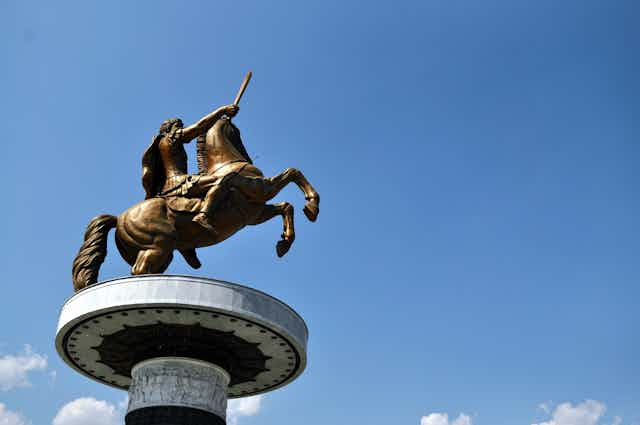In recent years, urban branding has become highly popular. Shifts in global, national, and local economic bases have forced cities and nations to market themselves internationally as cultural hotspots.

As cities with distinct cultures and recognisable architectural features are often more popular than those without them, some that lacked those unique features have gone as far as to reconstruct their architecture in an attempt to “reinvent” themselves. Recent examples include Bilbao, Singapore, Taipei, Kuala Lumpur, Shanghai, Beijing, Dubai, Abu Dhabi and Qatar.
In an attempt to show themselves as progressive, nations often look forward in stylistic terms when they try to establish their cities on the world stage. But one small European nation has curiously reversed this trend in an attempt to revive its “lost” history, prompting CNN to describe its capital as a “theme park”.
Skopje 2014, Macedonia
On February 1 2010, in an ambitious and uncanny revivalist attempt, the Macedonian government commissioned the reconstruction of the entire central district of its capital city in a quasi-baroque style.
The project, which was called “Skopje 2014” includes the commission of countless sculptures of art and monuments of historical figures, a wax museum, range of new government buildings built in a neoclassical style, Crystal Palace-like update on the parliament, new bridges, an Arch of Triumph, fountains, and a gigantic statue of Alexander the Great, to name a few.
Even the surrounding buildings built in the 1970s have been given a “facelift” by incorporating baroque elements on their facades. In order to complete the “look”, the government ordered a new fleet of vintage-looking double-decker buses to replace the regular bus fleet. This is a type of development that one might expect to see in Las Vegas, but not in Europe.
Skopje 1963, Yugoslavia
What makes this even more curious is the fact that Skopje has been under a major reconstruction once before. Except then Skopje was setting the world trends, rather then reversing them. When a massive earthquake in 1963 destroyed the city, a decision was made that Skopje should be rebuilt as a utopian, futuristic metropolis.
In an international competition, the Japanese architect Kenzo Tange, famous for his award-winning urban plan for Tokyo, was selected to apply the same design principles to Skopje.

Among a number of new iconic buildings, the small city also featured a landmark deconstructionist opera house that could rival the Sydney opera house in appearance, and a modern Museum of Contemporary Art where Picasso himself donated one of his works. In the period between 1970s to 1990s (until Macedonia’s independence from Yugoslavia), Skopje had all the hallmarks of a truly unique, cosmopolitan city. But not any more.
Why the change? The reasons behind Skopje 2014 are mostly political. Macedonia has two major external problems. On one hand, it is an aspiring EU candidate member country that never seems to come on the EU agenda for enlargement. On the other, the country still struggles to defend its right to a sovereign national identity.
Fortress Europe
As the EU becomes stronger and its internal borders become lower, its external borders become higher.

Countries that want to join the EU, but do not share a “European” identity, culture, and common core values, are faced with what some analysts call “fortress Europe”. These countries are not likely to become EU members until they thoroughly change. The EU already has problems imposing its own “umbrella” identity over the range of nations it represents, each with its own distinctive cultural identity. Dealing with new identities only further complicates things for them, and this is something that they are not willing to entertain.
From this perspective it seems that Macedonia has no other alternative than to create an image that presents a “genuine” but forgotten European state, and not as just another “barbaric” state lurking outside the EU’s borders. At the same time, in the face of the pressure from the neighbouring states (Greece in particular), it appears that Macedonia is also trying to inscribe its identity in stone, concrete and steel, in order to preserve it.
Implications
From a political point of view, Skopje 2014 makes sense because its purpose is to strengthen the national identity and to help the country build its pan-European image.

But this point of view doesn’t take into consideration other cultural or economic factors. As the originality and authenticity of the place is becoming progressively more “packaged”, the result becomes an imitation that exceeds the original to the point that the original no longer matters. A parallel to this can be made with the “imaginary world” of Disneyland — a place that tries to bring imagination and fiction together as reality. Amusing, yes; but hardly genuine.
Also, spending a fortune on buildings and monuments with no “Return On Investment” factor, during a global economic crisis, makes no real sense — regardless of how noble the idea is.
Therefore, most critics rightly argue that the funds spent on this project could have been better invested in infrastructure, technology, production facilities, hospitals, schools and libraries. Building monuments and landmark buildings can be instrumental in developing national identities, as well as in attracting visitors or investors.
The problem is that with Skopje 2014, Macedonia risks the faith of Easter Island if it spends all its resources on building massive monuments that can eventually bring them to ruins.

